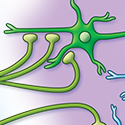Amy Hauck Newman, Ph.D., has been appointed the Scientific Director of the National Institute on Drug Abuse’s (NIDA) Intramural Research Program (IRP) in Baltimore. NIDA is part of the National Institutes of Health (NIH). Dr. Newman has served as NIDA’s IRP Acting Scientific Director for the past two years. She is also Chief of NIDA’s… [Read More]
News Main
In a Rat Model of Opioid Maintenance, the G Protein-Biased Mu Opioid Receptor Agonist TRV130 Decreases Relapse to Oxycodone Seeking and Taking and Prevents Oxycodone-Induced Brain Hypoxia
Hot Off the Press – November 17 , 2020 Bossert et al. used a rat model of opioid agonist maintenance therapy to study the effect of the novel G-protein-biased mu opioid receptor (MOR) agonist TRV130 on relapse oxycodone seeking and taking during abstinence. They showed that TRV130 decreased oxycodone seeking and taking during abstinence in… [Read More]
VTA Glutamatergic Neurons Mediate Innate Defensive Behaviors
Hot Off the Press – November 11 , 2020 The role of ventral tegmental area (VTA) in motivated behavior is well established. However, Barbano et al., demonstrated that a subset of VTA neurons, that utilizes glutamate as signaling molecule, mediates innate defensive behaviors, evolutionary selected responses that promote escaping from dangerous situations. Alterations in innate… [Read More]
Positive Allosteric Modulation of the 5-HT1A Receptor by Indole-Based Synthetic Cannabinoids Abused by Humans
Featured Paper of the Month – November 2020
Published in ACS Chemical Neuroscience in Yano, Hideaki; Adhikari, Pramisha; Naing, Sett; Hoffman, Alexander F; Baumann, Michael H; Lupica, Carl R; Shi, Lei
The nonmedical (i.e., recreational) misuse of synthetic cannabinoids (SCs) is a worldwide public health problem. When compared to cannabis, the misuse of SCs is associated with a higher incidence of serious adverse effects, suggesting the possible involvement of noncannabinoid sites of action. Here, we find that, unlike the phytocannabinoid Δ9-tetrahydrocannabinol, the indole-moiety containing SCs, AM2201 and JWH-018, act as positive allosteric modulators (PAMs) at the 5-HT1A receptor (5-HT1AR). This suggests that some biological effects of SCs might involve allosteric interactions with 5-HT1ARs…
Lorenzo Leggio Named 2020 Recipient of Jacob P. Waletzky Award by Society for Neuroscience
The Society for Neuroscience (SfN) has named Lorenzo Leggio, M.D., Ph.D. as the 2020 recipient of the Jacob P. Waletzky Award. The award, supported by the Waletzky Award Prize Fund and the Waletzky Family, is given to a young scientist whose independent research has led to significant conceptual and empirical contributions to the understanding of… [Read More]
Improving translation of animal models of addiction and relapse by reverse translation
Reviews To Read – October 2020. Recent advances in animal addiction models have emphasized translational challenges. In this Review, Venniro and colleagues introduce a reverse translational approach that may provide an ecologically relevant platform from which to discover new circuits, test new medications and improve translation.
Rajtarun Madangopal and Marco Venniro Awarded Brain & Behavior Research Foundation Young Investigator NARSAD Grants
The Brain & Behavior Research Foundation has awarded 2020 Young Investigator Grants to NIDA IRP staff members Rajtarun Madangopal and Marco Venniro. BBRF Young Investigator Grants provide each scientist with up to $35,000 per year for two years totaling $70,000 to enable promising investigators to either extend research fellowship training or begin careers as independent… [Read More]
Modafinil potentiates cocaine self-administration by a dopamine-independent mechanism: possible involvement of gap junctions
Featured Paper of the Month – October 2020
Published in Neuropsychopharmacology by Mereu, Maddalena; Hiranita, Takato; Jordan, Chloe J; Chun, Lauren E; Lopez, Jessica P; Coggiano, Mark A; Quarterman, Juliana C; Bi, Guo-Hua; Keighron, Jacqueline D; Xi, Zheng-Xiong; Newman, Amy Hauck; Katz, Jonathan L; Tanda, Gianluigi
Modafinil and methylphenidate are clinically available medications that inhibit the reuptake of dopamine in neurons, a common mechanism with psychostimulants like cocaine. We investigated the reinforcing actions of modafinil or methylphenidate alone and in combination with cocaine, in rats. While rats did not self-administer modafinil, suggesting low abuse liability, methylphenidate was self-administered similarly to cocaine. However, while both drugs potentiated cocaine’s reinforcing effects, only methylphenidate potentiated the elevated dopamine levels produced by cocaine…
NIDA IRP Staff Members Honored at 2020 NIH Director’s Awards
NIH Director’s Award: Yavin Shaham, NIDA For the development of novel animal models that have led to a paradigm shift in research on behavior and brain mechanisms of drug addiction. Ruth Kirchstein Mentoring Award: Marisela Morales, NIDA For exemplary performance while demonstrating significant leadership, skill, and ability in serving as a mentor. NIDA Staff members… [Read More]
Ayesha Sengupta awarded Women in Learning Research Grant
The Women in Learning Awards Committee has selected Ayesha Sengupta as the recipient of the 2020 “Where there’s a WIL there’s a way” Research Grant. This is the first award of its kind from WIL. It was designed to honor one outstanding yet underrepresented graduate student or post-doctoral fellow in the field of Learning &… [Read More]










